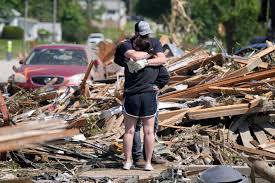On Tuesday afternoon, a powerful tornado swept across Greenfield, Iowa, leaving a trail of destruction in its wake. According to preliminary assessments, the tornado was at least an EF3 on the Enhanced Fujita Scale, indicating significant damage. As additional evaluations continue, the National Weather Service (NWS) cautioned that these results are subject to change. This article delves into the details of the tornado, its impact on Greenfield, and the ongoing response and recovery efforts.
Understanding the Tornado’s Impact
What is an EF3 Tornado?
Enhanced Fujita Scale Explained
The Enhanced Fujita Scale, used to rate the intensity of tornadoes, ranges from EF0 to EF5. An EF3 tornado features wind speeds between 136 and 165 mph and is capable of causing severe damage, such as uprooting trees, tearing off roofs, and destroying well-built homes.
Historical Context
EF3 tornadoes, though not as rare as EF4 or EF5, are still significant weather events. They account for a considerable portion of tornado-related destruction in the United States each year.
The Path of Destruction
Initial Touchdown
The tornado first touched down in Greenfield on Tuesday afternoon, moving rapidly through residential and commercial areas. Its initial impact was marked by widespread power outages and structural damage.
H3: Extent of Damage
While the NWS has not yet provided an exact path for the tornado, early reports indicate that several homes and businesses were severely damaged or destroyed. Vehicles were overturned, and debris was scattered across a wide area, complicating rescue and recovery efforts.
Community Response and Recovery
Immediate Aftermath
Emergency Services Mobilized
In the immediate aftermath, local emergency services were quick to respond. Firefighters, police officers, and medical personnel worked tirelessly to rescue trapped individuals and provide first aid to the injured.
Community Support
The Greenfield community has shown remarkable resilience and solidarity. Neighbors are helping each other clear debris, and local organizations are providing food, shelter, and other essential services to those affected.
Ongoing Damage Assessments
Role of the NWS
The NWS is conducting detailed damage assessments to determine the exact path and strength of the tornado. These assessments involve analyzing radar data, surveying the damage on the ground, and interviewing eyewitnesses.
Challenges Faced
One of the significant challenges in these assessments is the extensive area affected by the tornado. The scattered debris and damaged infrastructure make it difficult to access certain locations, slowing down the evaluation process.
Personal Stories of Survival
Tales of Resilience
A Family’s Narrow Escape
The Johnson family recounted their harrowing experience as the tornado approached. With only minutes to spare, they sought shelter in their basement, emerging unharmed but to a destroyed home. Their story is a testament to the importance of preparedness and quick thinking.
Community Heroes
Local heroes have emerged in the aftermath, such as the high school coach who used his own vehicle to transport injured residents to the hospital. These acts of bravery and kindness highlight the community’s strength and unity.
The Role of Technology in Tornado Response
Early Warning Systems
Importance of Timely Alerts
Early warning systems played a crucial role in minimizing casualties. Residents received timely alerts through their phones and local media, allowing them to take necessary precautions.
Technological Advancements
Advancements in meteorological technology have significantly improved tornado detection and warning systems. Doppler radar and satellite imagery provide real-time data, enabling more accurate predictions and faster alerts.
Social Media and Communication
Spreading the Word
Social media platforms were instrumental in spreading information quickly. Local authorities and residents used Twitter and Facebook to share updates, locate missing persons, and organize relief efforts.
Community Coordination
Through social media, volunteers coordinated their efforts more efficiently, ensuring that resources reached those in need promptly. This digital connectivity proved invaluable during the crisis.
Environmental and Long-term Impacts
Immediate Environmental Damage
Ecological Disruption
The tornado caused significant ecological disruption, uprooting trees, and destroying habitats. The immediate aftermath saw a stark transformation of the landscape, with large areas reduced to debris fields.
Water Contamination
In some areas, the debris and chemicals from damaged structures contaminated local water sources. Efforts are underway to clean and restore these vital resources to prevent long-term health risks.
Long-term Recovery Efforts
Rebuilding Infrastructure
Rebuilding Greenfield will be a long-term effort. Plans are already being formulated to reconstruct homes, businesses, and public facilities with improved resilience to future storms.
Mental Health Support
The psychological impact of the tornado is profound. Mental health services are being provided to help residents cope with the trauma and loss. Support groups and counseling sessions are essential components of the recovery process.
Lessons Learned and Future Preparedness
Importance of Preparedness
Community Drills
The Greenfield incident underscores the importance of regular community drills and preparedness programs. Being ready for such emergencies can save lives and reduce panic during actual events.
Emergency Kits
Maintaining emergency kits with essential supplies, such as water, food, and medical supplies, is crucial. These kits should be easily accessible and regularly updated.
Policy and Infrastructure Improvements
Building Codes
Updating building codes to ensure structures can withstand higher wind speeds can mitigate damage in future tornadoes. Investing in storm shelters and safe rooms is also essential.
Government Support
Government agencies at all levels must support affected communities with funding and resources. This support is vital for both immediate recovery and long-term rebuilding efforts.
The EF3 tornado that ravaged Greenfield, Iowa, serves as a stark reminder of nature’s power and the importance of preparedness. While the community faces significant challenges in the recovery process, their resilience and solidarity are commendable. By learning from this event, enhancing early warning systems, and improving infrastructure, we can better protect our communities from future disasters.




